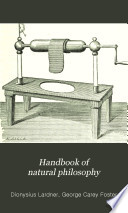 | Dionysius Lardner - Physics - 1874 - 520 pages
...resistance which the conductor opposes to the passage of the current (and which we will denote by R ) is directly proportional to the length of the conductor, and inversely proportional to its section and conducting power, we have and therefore the above expression for the heat evolved by... | |
 | Dionysius Lardner - Electric power - 1874 - 544 pages
...resistance which the conductor opposes to the passage of the current (and which we will denote by R ) is directly proportional to the length of the conductor, and inversely pro>portional to its section and conducting power, we Lave •R- l K. = j SC and therefore the above expression for... | |
 | Isaac Ott - Pharmacology - 1878 - 214 pages
...its transverse section, then the resistance will be represented by ^, that is, the resistance is ^ proportional to the length of the conductor, and inversely proportional to the square of its diameter. If now D represent density and I the intensity of the current at the transverse... | |
 | Joseph M'Gregor Robertson - Biophysics - 1884 - 558 pages
...which is a constant quantity for each conductor. Apart, however, from that, the external resistance is directly proportional to the length of the conductor, and inversely proportional to the cross-section ; ie the longer the conductor the greater the resistance, and the thicker the conductor... | |
 | Joseph M'Gregor Robertson - 1884 - 554 pages
...which is a constant quantity for each conductor. Apart, however, from that, the external resistance is directly proportional to the length of the conductor, and inversely proportional to t/ie cross-section; ie the longer the conductor the greater the resistance, and the thicker the conductor... | |
 | Medicine - 1888 - 596 pages
...with the nature of that conductor; that is, it is dependent upon its conductibility, and, moreover, it is directly proportional to the length of the conductor and inversely proportional to its diameter: consequently a battery is as much less resistant as the active immersed surfaces are... | |
 | Canadian Society of Civil Engineers - Engineering - 1890 - 832 pages
...wherein it is shown (see note page 260) that the time required to actuate an electro-magnet is about directly proportional to the length of the conductor and inversely proportional to its conductivity. An actual experiment is cited, p. 395, whereby it was ascertained that on a No. 8... | |
 | G. W. Lummis Paterson - Electric generators - 1895 - 296 pages
...resistance are very simple, and may be briefly stated as follows :—"The resistance of a conductor is proportional to the length of the conductor, and inversely proportional to the cross section of the conductor, and also depends upon the material of which the conductor is made,... | |
 | Mines and mineral resources - 1896 - 330 pages
...current (symbol, R. ; unit, the ohm) corresponds to the friction of water in a pipe. This resistance is directly proportional to the length of the conductor, and inversely proportional to its area of cross section. (5) The electric current is equal to the electromotive force divided by... | |
 | Christian Christiansen - Mathematical physics - 1897 - 360 pages
...and B respectively, we have i = CS (Vand further (c) i = (V - r)/(l/CS) = (F- F')/R. The resistance R is directly proportional to the length of the conductor and inversely proportional to its cross-section, and to the conductivity of the substance constituting the conductor. The difference... | |
| |